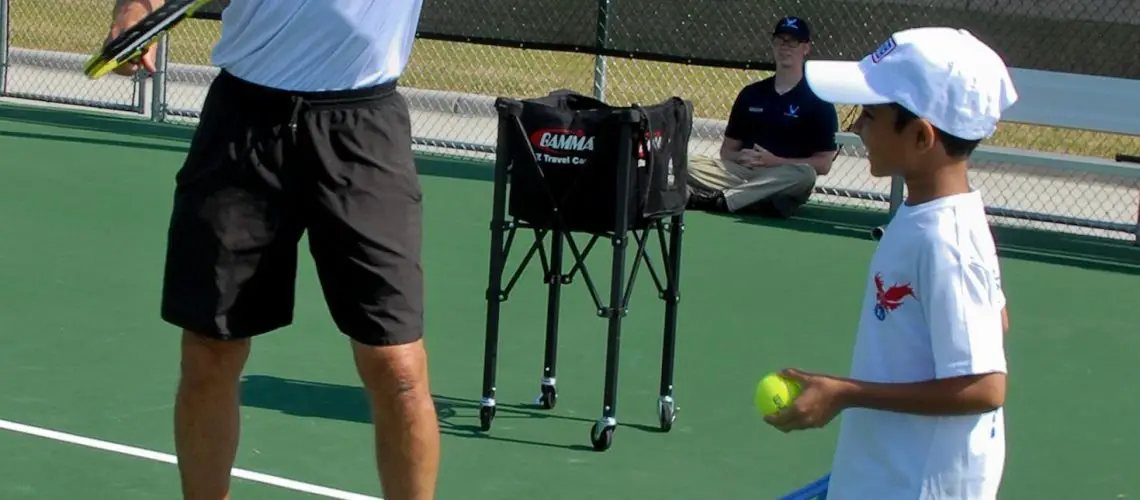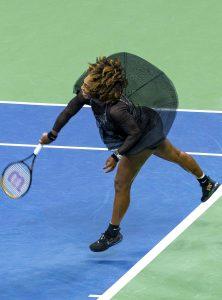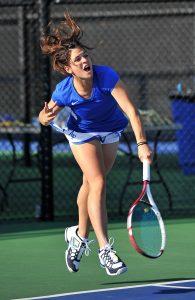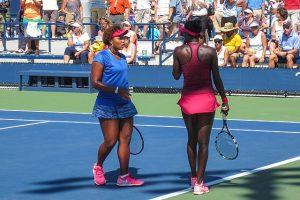We may earn money or products from the companies mentioned in this post.
What Is Hindrance In Tennis?

In the fast-paced world of tennis, hindrance refers to any action or event that disrupts the flow of play It can be an intentional act by a player or an unintentional interference caused by external factors Regardless of its origin, a hindrance has the potential to impact the outcome of a match
An Action That Disrupts Play
When we talk about hindrances in tennis, we’re referring to actions that impede the progress of a point This could include anything from obstructing an opponent’s shot by standing in their way, to making excessive noise during play that distracts the players These actions can disrupt concentration and affect the rhythm and strategy of both players
Deliberate or Unintentional Interference
A hindrance can be deliberate, where a player intentionally interferes with their opponent’s ability to play a shot This could involve shouting out during their opponent’s serve or deliberately distracting them with sudden movements On the other hand, hindrances can also be unintentional, such as a ball rolling onto the court from another court nearby or a spectator causing a disturbance
The Importance of Understanding Hindrance Rules

To ensure fair play and maintain sportsmanship in tennis matches, it is crucial for players and spectators alike to have a clear understanding of hindrance rules By knowing what constitutes as a hindrance and how it should be handled, everyone involved in the game can uphold its integrity and avoid unnecessary penalties or disputes
Ensuring Fair Play and Sportsmanship
Hindrance rules are designed to promote fair play on the tennis court By adhering to these rules, players show respect for their opponents and uphold the principles of good sportsmanship They understand that intentionally hindering their opponent’s play goes against the spirit of the game and undermines its competitive nature
Avoiding Penalties and Disputes During Matches
Not knowing or disregarding hindrance rules can lead to penalties or disputes during matches If a player repeatedly engages in hindrances, they may receive warnings, point deductions, or even disqualification By familiarizing themselves with these rules, players can avoid unnecessary conflicts and ensure a smooth and enjoyable tennis experience for themselves and others involved
Understanding what constitutes as a hindrance in tennis is essential for players, spectators, and officials alike It helps maintain fairness on the court while promoting sportsmanship among competitors By being knowledgeable about these rules, everyone can contribute to a positive and harmonious tennis environment
Types of Hindrances in Tennis

In the fast-paced and competitive world of tennis, hindrances can often disrupt the flow of a match and have a significant impact on a player’s performance These hindrances can be categorized into two main types: player-caused hindrances and external hindrances
Player-Caused Hindrances
Player-caused hindrances refer to distractions or obstacles that are directly caused by the players themselves These hindrances can be intentional or accidental, but either way, they can disrupt the concentration and rhythm of the game
-
Deliberate Distractions:
One common form of player-caused hindrance is when a player intentionally tries to distract their opponent through audible or visible signals This could include making noise during serves or shots, or using exaggerated body movements to throw off their opponent’s focus -
Accidental Distractions:
Sometimes, distractions in tennis occur unintentionally For example, dropping a racquet or hat during a crucial point can break the momentum of both players and create an unexpected interruption -
Body Contact:
In doubles matches, body contact between players can occur accidentally while chasing down a shot Collisions can disrupt play and potentially cause injuries if not managed properly -
Invasion of Opponent’s Court Space:
Another form of player-caused hindrance is when one player deliberately invades their opponent’s court space during play This invasion may obstruct their opponent’s movement or limit their ability to execute shots effectively
External Hindrances
In addition to player-caused hindrances, there are external factors that can also impact the smooth flow of a tennis match These hindrances originate from sources outside the players themselves, often beyond their control
-
Ball Interference from Adjacent Courts:
Tennis courts are often situated close to each other, and sometimes balls from adjacent courts can accidentally roll onto the court in play This unexpected ball interference can disrupt the rhythm of the game and require a stoppage to rectify -
Distractions Caused by Spectators or Officials:
The presence of spectators or officials can also introduce distractions during a tennis match Noise from the crowd or sudden movements by officials may divert players’ attention away from their game plan and affect their performance -
Environmental Factors:
Environmental factors can pose challenges on the tennis court For instance, wind-blown debris such as leaves or dust can accumulate on the playing surface, making it difficult for players to move swiftly and maintain proper footing
In conclusion, hindrances in tennis come in various forms and can significantly impact a player’s focus and performance Whether caused by players themselves or external factors, managing these hindrances requires mental fortitude and adaptability to ensure fair play and maintain a level playing field for all competitors
Introduction

Welcome to the exciting world of tennis, where every swing and serve can make or break a game In this article, we’ll delve into the concept of “icing” in tennis, exploring its definition, origin, and how it connects to other sports with similar concepts
A Brief Explanation of Icing in Tennis
Icing in tennis refers to a strategic move employed by players during crucial moments in a match It involves intentionally delaying the start of a serve or return, creating a momentary pause before initiating the shot This technique aims to disrupt the opponent’s rhythm and concentration, potentially throwing them off balance and giving an advantage to the player implementing the icing tactic
The term “icing” originated from ice hockey, where it describes a defensive maneuver used by teams to delay play by shooting the puck down the rink without any intention of scoring This intentional stoppage in play allows players on both sides to regroup mentally and physically Similarly, in tennis, icing serves as a psychological ploy used strategically to gain an edge over opponents
Connection to Other Sports with Similar Concepts
Icing is not unique to tennis or ice hockey; several other sports have similar tactics aimed at disrupting opponents’ flow In basketball, for instance, coaches often call timeouts just before an opposing player shoots free throws This break interrupts their rhythm and introduces mental pressure that may affect their performance
In American football, teams might use timeouts right before crucial plays or field goal attempts The goal is twofold: first, it disrupts the opposing team’s momentum and secondly it allows time for strategizing or forcing them into making rushed decisions
Importance of Understanding Icing in Tennis

Now that we have explored what icing entails, let’s discuss why it’s essential for players, coaches, and even spectators to grasp this concept
Enhancing Gameplay and Strategy
Icing is a strategic tool that can significantly impact the outcome of a tennis match By understanding when and how to employ this tactic, players can gain an advantage over their opponents It opens up opportunities to break their rhythm, disrupt their focus, and potentially force errors or weak shots
Moreover, knowledge of icing allows players to anticipate and counteract the strategy if used against them They can mentally prepare themselves for potential interruptions in play and develop techniques to maintain concentration despite these disturbances
Avoiding Penalties and Confusion
While icing can be an effective technique when used appropriately, there are certain rules and guidelines surrounding its execution Understanding these regulations helps players avoid penalties that may result from improper use of icing tactics
Additionally, comprehension of icing prevents confusion among both players and spectators When everyone involved understands the purpose behind intentional pauses during serves or returns, it eliminates any potential misunderstandings or debates about fair play
In conclusion
The Elements of Icing in Tennis

In the fast-paced world of tennis, there’s a strategic move known as “icing” that can disrupt an opponent’s rhythm and concentration Let’s dive into the elements that make up this intriguing tactic
Identifying when icing occurs
Icing occurs when players intentionally stall or delay the game to gain an advantage It can be quite frustrating for both players and spectators alike Here are a few signs to look out for:
-
Deliberate stalling tactics:
This includes taking extra time between points or during changeovers Players might use this time to catch their breath, psych out their opponent, or break their momentum -
Unintentional vs intentional icing tactics:
While some delays may be due to legitimate reasons like injuries or cramps, others are carefully orchestrated ploys to disrupt play
To further examine these tactics, let’s explore some specific examples:
-
Taking extra time between points or during changeovers:
By extending the time spent between points or during changeovers, players can throw off their opponent’s timing and mental focus -
Excessive bouncing or spinning racquet before serving:
Some players employ repetitive racquet movements before serving as a way to create tension and anticipation in their opponents
Rule violations related to icing in tennis
To maintain fairness and sportsmanship on the court, governing bodies such as the International Tennis Federation (ITF) have established rules against icing tactics Let’s take a closer look at these regulations:
-
Time violation rules from the ITF:
Time limits are set between points, games, and sets to ensure a smooth flow of play Violating these time limits can result in penalties -
Consequences for time violations:
Players may receive warnings, point penalties, or even disqualification if they repeatedly exceed the specified time limits
In addition to time violations, intentional stalling can also lead to unsportsmanlike conduct penalties This ensures that players compete fairly and maintain the integrity of the game
Tennis is not just about skill; it’s also about mental strength and strategy Understanding the elements of icing tactics gives players and fans alike a deeper appreciation for the nuances of this captivating sport
Strategies to Counteract Icing in Tennis

In the fast-paced world of tennis, opponents sometimes employ icing techniques to disrupt their opponent’s rhythm and concentration These delays can be frustrating, but with the right strategies, you can stay focused and maintain your competitive edge Here are some tactics to counteract icing in tennis:
Tactics for Staying Focused during Delays
When faced with delays caused by opponents’ icing techniques, it’s crucial to stay mentally strong and composed One effective approach is to incorporate breathing exercises and mental visualization techniques into your routine By practicing relaxation strategies, such as deep breathing or progressive muscle relaxation, you can maintain calmness on the court even amidst distractions Additionally, visualizing successful shots and game outcomes can boost your confidence and keep you motivated
To further combat any frustration caused by delays, it’s important to stay physically prepared during breaks This could involve maintaining movement through dynamic stretching or light jogging By keeping your body active and engaged, you’ll be ready to jump back into the game when play resumes It’s also essential to hydrate properly and refuel with energy snacks as needed to maintain optimal performance throughout the match
Adapting Gameplay Strategies after Icing Attempts
When an opponent employs icing techniques, it’s crucial to adapt your gameplay strategies accordingly One effective tactic is changing up serve patterns, pace, or spin after a delay caused by icing attempts By introducing variation into your serves, you can catch your opponent off guard and regain control of the game
Moreover, take advantage of the pause in play caused by icing attempts to reassess your opponent’s weaknesses carefully Observe their playing style closely during these moments of interruption and identify areas where they may be vulnerable or struggling Armed with this knowledge, you can adjust your tactics and exploit their weaknesses to gain an advantage
By implementing these strategies, you can effectively counteract icing techniques in tennis Staying focused during delays and adapting your gameplay strategies will help you maintain control of the game and overcome any challenges posed by opponents who employ icing tactics
Conclusion
In conclusion, icing in tennis is a strategic tactic employed by players to disrupt their opponents’ rhythm and concentration Understanding the impact it has on gameplay is crucial for both players and spectators
Summary of Icing in Tennis and Its Impact on Gameplay
Icing refers to deliberate actions taken by a player to delay the start of a point or interrupt their opponent’s momentum This can be done through various tactics such as excessive ball bouncing, lengthy towel breaks, or taking extra time between serves The purpose of icing is to break the flow of the game and unsettle the opponent’s focus
It is important for players to recognize when their opponents are employing icing tactics so they can adjust their own strategies accordingly
Stressing the Importance of Mental and Physical Preparation to Counteract Icing
To counteract icing, players must prioritize mental and physical preparation
1 Emphasizing Focus, Adaptability, and Resilience on Court:
Maintaining focus despite interruptions is key Players should train themselves to quickly adapt to unexpected breaks in play and stay mentally strong throughout the match
2 Encouraging Fair Play and Sportsmanship in Competitive Tennis:
While it may be tempting to retaliate with similar tactics, players should prioritize fair play and sportsmanship over gamesmanship By focusing on playing within the rules and maintaining a positive attitude, they can counteract any attempts at icing more effectively
In conclusion, understanding icing in tennis allows players to anticipate these tactics from opponents while emphasizing mental fortitude and fair play ultimately leads to a more enjoyable experience for everyone involved in competitive tennis
Useful Links

Icing In Tennis(3 Easy Steps To Fix Icing On Ball) – Sportsalizer
21 what is icing in tennis Advanced Guide
Don’t Use Ice to Treat Your Tennis Elbow! (Really)
Sports Icing Transfer Sheet/tennis Royal Icing
Tennis Match | Edible icing sheets, Edible toppers, Tennis
Tail Women`s Mirella Tennis Tank Icing
Tennis Toilet Break Rules, Time-Limit and Controversies …
Tennis Racket Royal Icing Transfer Design (3 sizes)
Health Icing Injuries – WTA
What Does Icing Mean in Tennis? – Sports Paradox
Icing the kicker
TENNIS COURT CAKE TOPPER A4 EDIBLE ICED …
Silver Crystal Bezeled Tennis Bracelet
THE ICING ON THE CAKE:… – Averett University Tennis
Tennis Edible Icing Image
Sep 2, 2017
icing tennis elbow
2.83 ctw Lab Diamond Tennis Bracelet (7001273)






